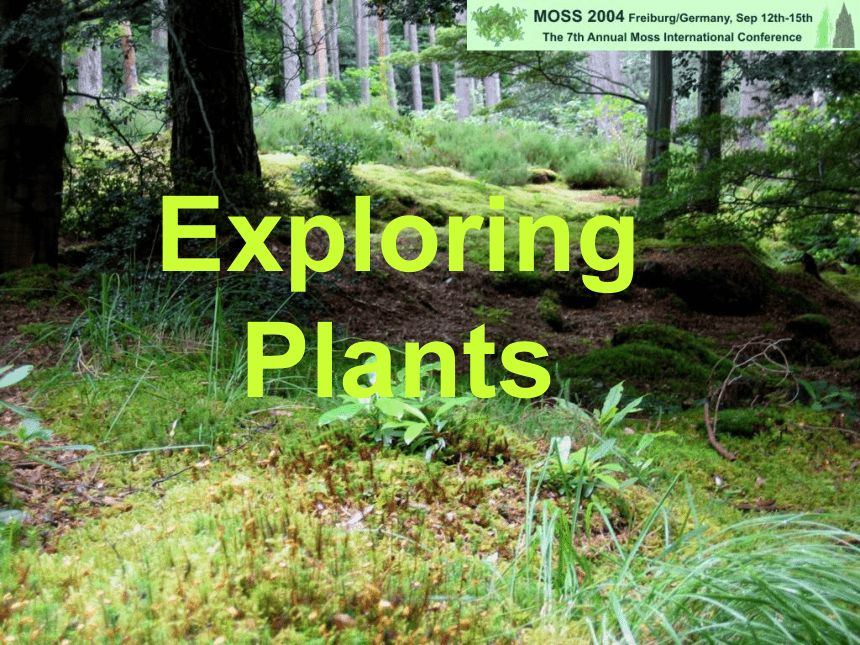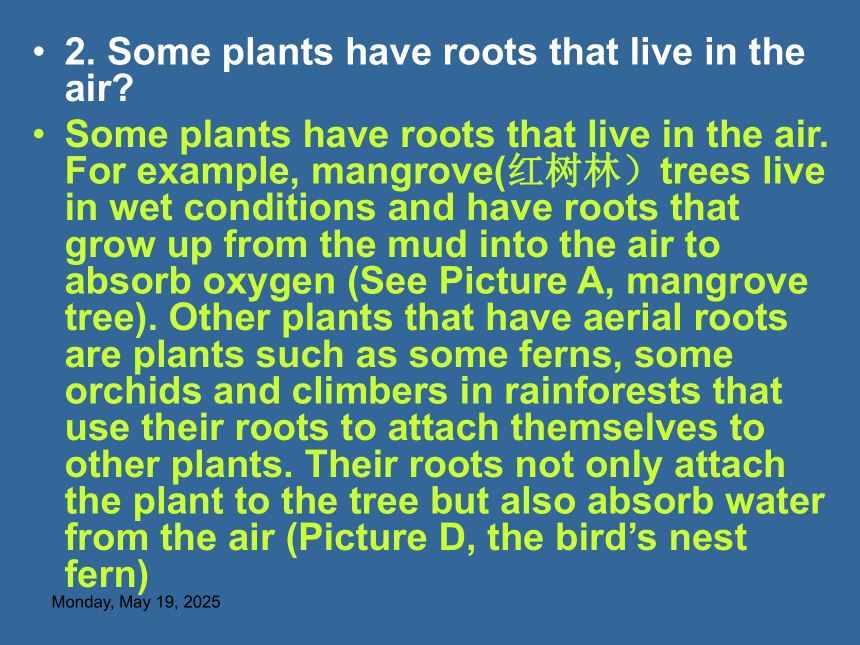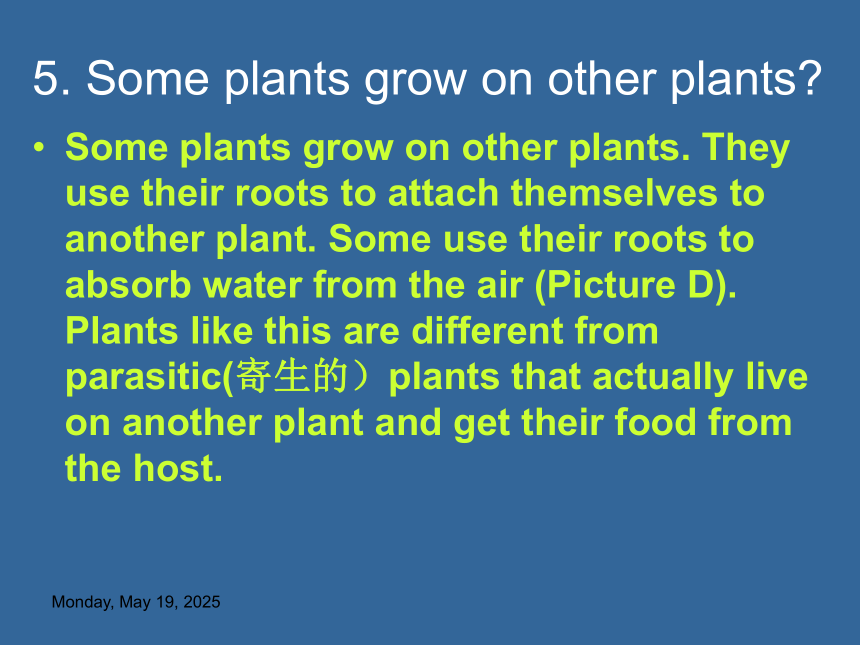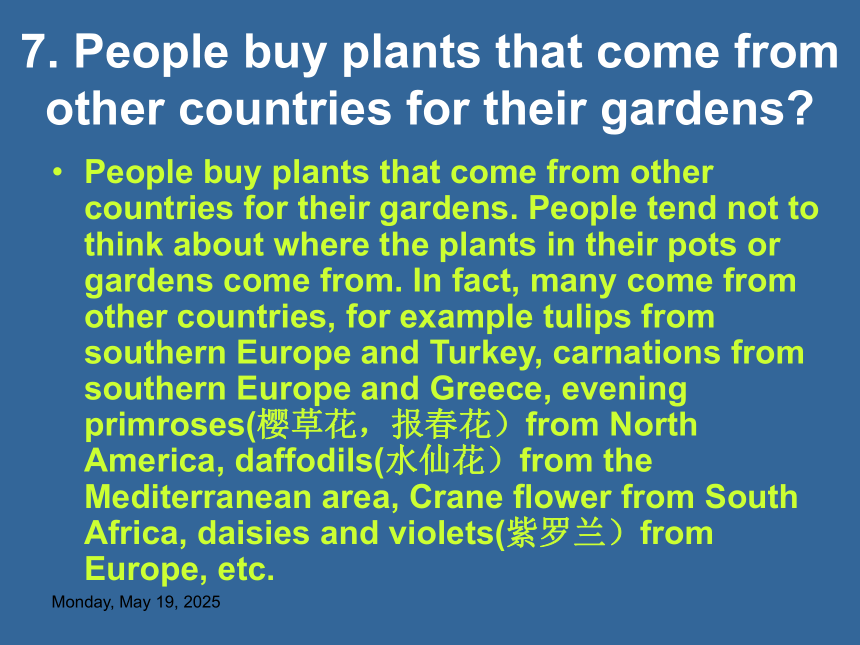选修 9 Unit 4 Reading (人教版 )[上学期]
文档属性
| 名称 | 选修 9 Unit 4 Reading (人教版 )[上学期] |  | |
| 格式 | rar | ||
| 文件大小 | 346.9KB | ||
| 资源类型 | 教案 | ||
| 版本资源 | 人教版(新课程标准) | ||
| 科目 | 英语 | ||
| 更新时间 | 2006-09-13 08:37:00 | ||
图片预览









文档简介
课件27张PPT。Exploring
PlantsSaturday, March 09, 2019Warming-up
What do you know about plants? Answer the following questions. Then in groups, see how much you know about the plants mentioned in the questions. Give examples of particular plants if you can.Saturday, March 09, 2019Warming--up1.Some plants do not have flowers?
Some plants do not have flowers, for example pine trees, cypress tree(柏木属植物), ferns(蕨类植物), mushrooms. With these plants, the seeds are not contained inside a fruit. Flowering plants have seeds that are contained inside fruit.Saturday, March 09, 20192. Some plants have roots that live in the air?
Some plants have roots that live in the air. For example, mangrove(红树林)trees live in wet conditions and have roots that grow up from the mud into the air to absorb oxygen (See Picture A, mangrove tree). Other plants that have aerial roots are plants such as some ferns, some orchids and climbers in rainforests that use their roots to attach themselves to other plants. Their roots not only attach the plant to the tree but also absorb water from the air (Picture D, the bird’s nest fern)Saturday, March 09, 20193. Some plants eat meat?Some plants eats meat. They get their food from animals trapping insects that land on them, killing them and then digesting their bodies with chemicals. Picture B shows an insect-eating plant called a Venus flytrap. When the hairs on the leaves are touched by an insect, the two parts or the leaf snap together and trap the victim.Saturday, March 09, 20194. Some plants need animals to pollinate them?Some plants need animals to pollinate them. They have developed flowers with different characteristics to attract particular animal pollinators such as bees, flies, butterflies, birds, bats, beetles, and moths. Plants that do not have flowers need other ways of making sure that they are pollinated, for example, corn, grasses and many trees depend on the wind or water to transport pollen from one plant to another.Saturday, March 09, 20195. Some plants grow on other plants?Some plants grow on other plants. They use their roots to attach themselves to another plant. Some use their roots to absorb water from the air (Picture D). Plants like this are different from parasitic(寄生的)plants that actually live on another plant and get their food from the host.Saturday, March 09, 20196. Plants are adapted to live in specific environment?Plants are adapted to living in specific environments. For example, plants that live in the tropics are adapted to living in a hot wet climate. Picture C shows palms that live in tropical climates. Plants that are used to cold conditions cannot necessarily live in hot conditions.Saturday, March 09, 20197. People buy plants that come from other countries for their gardens?People buy plants that come from other countries for their gardens. People tend not to think about where the plants in their pots or gardens come from. In fact, many come from other countries, for example tulips from southern Europe and Turkey, carnations from southern Europe and Greece, evening primroses(樱草花,报春花)from North America, daffodils(水仙花)from the Mediterranean area, Crane flower from South Africa, daisies and violets(紫罗兰)from Europe, etc.Saturday, March 09, 20198. A new plant does not always grow from a seed?A new plant does not always grow from a seed. New plants often grow from underground roots or stems, for example, the bamboo makes new plants by sending up new shoots form underground stems. Strawberry plants and many grasses and some ferns send out stems that run along the top or the ground and new plants grow along these stems. Other plants, like the daffodil, make new plants from bulbs. New plants can also grow from stems that have been cut from a plant.Saturday, March 09, 2019Pre-reading1. Do you have a courtyard garden or some pot plants on your balcony? Do you know where these plants come from? Are they Chinese plants or do they come from another country?
2. When you last visited a public garden, did you look at the individual plants there ? Were there any plants from other countries?
3. How do you think plants have travelled from one country to another?
4. Scan the title of the reading passage and the pictures and predict what it is about.Saturday, March 09, 2019Reading--- PLANT EXPLORATION IN THE 18TH AND 19TH CENTURIESSTEP 1
Scan the text as quickly as you can to find the answers to the following questions.
① What is an exotic plant?
② What was the name of Lieutenant James Cook’s ship?
③ Why did James Cook call the bay where his ship stopped “Botany Bay”
④ Why were the sealed glass containers called “Wardian” Cases?
⑤ What were the names of the people mentioned in the text who collected plants in the 18th and 19th centuries?
⑥ Why do you think the plant shown in the photo on page 33 was called the Dove Tree?Saturday, March 09, 2019① What is an exotic plant?
A plant that comes from another country.
② What was the name of Lieutenant James Cook’s ship?
The endeavor.
③ Why did James Cook call the bay where his ship stopped “Botany Bay”?
Because it was the bay that Joseph Banks collected many new botanical specimens.
④ Why were the sealed glass containers called “Wardian” Cases?
Because they were named after the person who invented them---Nathaniel Ward
Saturday, March 09, 2019⑤ What were the names of the people mentioned in the text who collected plants in the 18th and 19th centuries?
Father d’Incarville, Sir Joseph Banks, Robert Fortune, Father Farges, EH Wilson.
⑥ Why do you think the plant shown in the photo on page 33 was called the Dove Tree?
Because the flowers look like white doves.
Saturday, March 09, 2019STEP2 COMPREHENDING1. What is each paragraph about? Write down the topic of each paragraph in your own words.
Paragraph 1
Explains when plant collecting began
When plant collecting began
Paragraph2
describes when and where plant collecting began on a large scale by Europeans.
When and where plant collecting began on a large scaleSaturday, March 09, 2019Paragraph 3
Talks about French Catholic missionaries who collected plants in China in the 18th Century.
French Catholic missionaries collected plants in China in the 18th century.
Paragraph 4
Is about the famous British plant collector, Sir Joseph Banks, who collected many new plants in Australia.
The famous British plant collector, Sir Joseph BanksSaturday, March 09, 2019Paragraph 5
Explains the problems of keeping plants alive on long trips
Problem of keeping plants alive on long trips.
Paragraph 6
Describes an experiment carried out by Dr Nathaniel Ward who invented a glass case in which to transport plants on long journeys
Wardian caseSaturday, March 09, 2019Paragraph 7
Is about Robert Fortune, a British plant collector who made several trips to China in the 19th Century.
How Robert Fortune introduced Chinese tea to the West.
Paragraph 8
Is about Father Farges, a French Catholic missionary who collected plants in China in the 19th century.
Father Farges and the Dove Tree.Saturday, March 09, 2019Paragraph 9
Describes how many European plat collectors, such as E H Wilson, went to China so that new plants could be introduced to gardens in the west.
Many European plant collectors collected many plants to western gardens.Saturday, March 09, 2019Comprehending 2
What happened in these years? Complete the sentences.
① IN 1500 BC,________________________.
the Queen of Egypt sent ships to gather plants, animals and other goods.
② IN the 1740s, _______________________.
a French Catholic missionary called Father d’Incarville was sent to Beijing.
③ IN 1751, ___________________________.
some Tree of Heaven seeds arrived in England.
Saturday, March 09, 2019④ IN 1769, __________________________.
Sir Joseph Banks collected vast quantities of plants in the land now known as Australia.
⑤ IN 1784, __________________________.
The Tree of Heaven was introduced into North America.
⑥ IN 1833, __________________________.
Nathaniel Ward used two special cases that he had invented to ship British plants to Sydney.Saturday, March 09, 2019⑦ Between 1843 and 1859,____________.
a British plant collector, Robert Fortune, made several trips to China.
⑧ During the second half of the 19th Century, ___________________________.
many Catholic missionaries were sent to China from France.
⑨ In 1897, _________________________.
a French plant collector, Father Farges, sent seeds of the Dover Tree from China to France.Saturday, March 09, 2019⑩ IN 1899, _________________________.
a plant collector, E H Wilson, collected a large quantity of the seeds of the Dove Tree in China.Saturday, March 09, 2019Comprehending 31. Why was there a lot of plant collecting in the 18th and 19th centuries?
2. How did French missionaries come to be plant collectors?
3. What were some of the negative aspects of plant collecting expeditions?
4. Transporting plants over long distances was a big problem. Why was this?
5. Why did many plants fail to reach their destinations alive? Can you think of any other reasons?
6. What improved the survival rates of plants transported long distances?Saturday, March 09, 20191. Why was there a lot of plant collecting in the 18th and 19th centuries?
Europe had become interested in Scientific discovery and the European middle classes took great interest in collecting new plants at this time.
2. How did French missionaries come to be plant collectors?
They valued the study of the natural sciences and many of them knew a lot about plants and animals.Saturday, March 09, 20193. What were some of the negative aspects of plant collecting expeditions?
Negative aspects included disease, near-starvation, severe environment, conflicts with the local people, plants dying during long trips or seeds failing to grow after long trips, pirates, bad weather (like thunderstorms), not knowing the local language and customs, etc.
4. Transporting plants over long distances was a big problem. Why was this?
It was hard to keep them alive during long trips.
Saturday, March 09, 20195. Why did many plants fail to reach their destinations alive? Can you think of any other reasons?
The seeds of many plants failed to grow after long trips: plants were not looked after properly during the trip. For example, one plant explorer lost his plants when they were watered with sea water. Other reasons include lack of fresh water, wrong environmental conditions, for instance, incorrect temperatures, salty air, and lack of sunlight and rain, etc, if the plants were transported inside the ship or train.
6. What improved the survival rates of plants transported long distances?
It was the invention of Wardian case.Saturday, March 09, 2019
PlantsSaturday, March 09, 2019Warming-up
What do you know about plants? Answer the following questions. Then in groups, see how much you know about the plants mentioned in the questions. Give examples of particular plants if you can.Saturday, March 09, 2019Warming--up1.Some plants do not have flowers?
Some plants do not have flowers, for example pine trees, cypress tree(柏木属植物), ferns(蕨类植物), mushrooms. With these plants, the seeds are not contained inside a fruit. Flowering plants have seeds that are contained inside fruit.Saturday, March 09, 20192. Some plants have roots that live in the air?
Some plants have roots that live in the air. For example, mangrove(红树林)trees live in wet conditions and have roots that grow up from the mud into the air to absorb oxygen (See Picture A, mangrove tree). Other plants that have aerial roots are plants such as some ferns, some orchids and climbers in rainforests that use their roots to attach themselves to other plants. Their roots not only attach the plant to the tree but also absorb water from the air (Picture D, the bird’s nest fern)Saturday, March 09, 20193. Some plants eat meat?Some plants eats meat. They get their food from animals trapping insects that land on them, killing them and then digesting their bodies with chemicals. Picture B shows an insect-eating plant called a Venus flytrap. When the hairs on the leaves are touched by an insect, the two parts or the leaf snap together and trap the victim.Saturday, March 09, 20194. Some plants need animals to pollinate them?Some plants need animals to pollinate them. They have developed flowers with different characteristics to attract particular animal pollinators such as bees, flies, butterflies, birds, bats, beetles, and moths. Plants that do not have flowers need other ways of making sure that they are pollinated, for example, corn, grasses and many trees depend on the wind or water to transport pollen from one plant to another.Saturday, March 09, 20195. Some plants grow on other plants?Some plants grow on other plants. They use their roots to attach themselves to another plant. Some use their roots to absorb water from the air (Picture D). Plants like this are different from parasitic(寄生的)plants that actually live on another plant and get their food from the host.Saturday, March 09, 20196. Plants are adapted to live in specific environment?Plants are adapted to living in specific environments. For example, plants that live in the tropics are adapted to living in a hot wet climate. Picture C shows palms that live in tropical climates. Plants that are used to cold conditions cannot necessarily live in hot conditions.Saturday, March 09, 20197. People buy plants that come from other countries for their gardens?People buy plants that come from other countries for their gardens. People tend not to think about where the plants in their pots or gardens come from. In fact, many come from other countries, for example tulips from southern Europe and Turkey, carnations from southern Europe and Greece, evening primroses(樱草花,报春花)from North America, daffodils(水仙花)from the Mediterranean area, Crane flower from South Africa, daisies and violets(紫罗兰)from Europe, etc.Saturday, March 09, 20198. A new plant does not always grow from a seed?A new plant does not always grow from a seed. New plants often grow from underground roots or stems, for example, the bamboo makes new plants by sending up new shoots form underground stems. Strawberry plants and many grasses and some ferns send out stems that run along the top or the ground and new plants grow along these stems. Other plants, like the daffodil, make new plants from bulbs. New plants can also grow from stems that have been cut from a plant.Saturday, March 09, 2019Pre-reading1. Do you have a courtyard garden or some pot plants on your balcony? Do you know where these plants come from? Are they Chinese plants or do they come from another country?
2. When you last visited a public garden, did you look at the individual plants there ? Were there any plants from other countries?
3. How do you think plants have travelled from one country to another?
4. Scan the title of the reading passage and the pictures and predict what it is about.Saturday, March 09, 2019Reading--- PLANT EXPLORATION IN THE 18TH AND 19TH CENTURIESSTEP 1
Scan the text as quickly as you can to find the answers to the following questions.
① What is an exotic plant?
② What was the name of Lieutenant James Cook’s ship?
③ Why did James Cook call the bay where his ship stopped “Botany Bay”
④ Why were the sealed glass containers called “Wardian” Cases?
⑤ What were the names of the people mentioned in the text who collected plants in the 18th and 19th centuries?
⑥ Why do you think the plant shown in the photo on page 33 was called the Dove Tree?Saturday, March 09, 2019① What is an exotic plant?
A plant that comes from another country.
② What was the name of Lieutenant James Cook’s ship?
The endeavor.
③ Why did James Cook call the bay where his ship stopped “Botany Bay”?
Because it was the bay that Joseph Banks collected many new botanical specimens.
④ Why were the sealed glass containers called “Wardian” Cases?
Because they were named after the person who invented them---Nathaniel Ward
Saturday, March 09, 2019⑤ What were the names of the people mentioned in the text who collected plants in the 18th and 19th centuries?
Father d’Incarville, Sir Joseph Banks, Robert Fortune, Father Farges, EH Wilson.
⑥ Why do you think the plant shown in the photo on page 33 was called the Dove Tree?
Because the flowers look like white doves.
Saturday, March 09, 2019STEP2 COMPREHENDING1. What is each paragraph about? Write down the topic of each paragraph in your own words.
Paragraph 1
Explains when plant collecting began
When plant collecting began
Paragraph2
describes when and where plant collecting began on a large scale by Europeans.
When and where plant collecting began on a large scaleSaturday, March 09, 2019Paragraph 3
Talks about French Catholic missionaries who collected plants in China in the 18th Century.
French Catholic missionaries collected plants in China in the 18th century.
Paragraph 4
Is about the famous British plant collector, Sir Joseph Banks, who collected many new plants in Australia.
The famous British plant collector, Sir Joseph BanksSaturday, March 09, 2019Paragraph 5
Explains the problems of keeping plants alive on long trips
Problem of keeping plants alive on long trips.
Paragraph 6
Describes an experiment carried out by Dr Nathaniel Ward who invented a glass case in which to transport plants on long journeys
Wardian caseSaturday, March 09, 2019Paragraph 7
Is about Robert Fortune, a British plant collector who made several trips to China in the 19th Century.
How Robert Fortune introduced Chinese tea to the West.
Paragraph 8
Is about Father Farges, a French Catholic missionary who collected plants in China in the 19th century.
Father Farges and the Dove Tree.Saturday, March 09, 2019Paragraph 9
Describes how many European plat collectors, such as E H Wilson, went to China so that new plants could be introduced to gardens in the west.
Many European plant collectors collected many plants to western gardens.Saturday, March 09, 2019Comprehending 2
What happened in these years? Complete the sentences.
① IN 1500 BC,________________________.
the Queen of Egypt sent ships to gather plants, animals and other goods.
② IN the 1740s, _______________________.
a French Catholic missionary called Father d’Incarville was sent to Beijing.
③ IN 1751, ___________________________.
some Tree of Heaven seeds arrived in England.
Saturday, March 09, 2019④ IN 1769, __________________________.
Sir Joseph Banks collected vast quantities of plants in the land now known as Australia.
⑤ IN 1784, __________________________.
The Tree of Heaven was introduced into North America.
⑥ IN 1833, __________________________.
Nathaniel Ward used two special cases that he had invented to ship British plants to Sydney.Saturday, March 09, 2019⑦ Between 1843 and 1859,____________.
a British plant collector, Robert Fortune, made several trips to China.
⑧ During the second half of the 19th Century, ___________________________.
many Catholic missionaries were sent to China from France.
⑨ In 1897, _________________________.
a French plant collector, Father Farges, sent seeds of the Dover Tree from China to France.Saturday, March 09, 2019⑩ IN 1899, _________________________.
a plant collector, E H Wilson, collected a large quantity of the seeds of the Dove Tree in China.Saturday, March 09, 2019Comprehending 31. Why was there a lot of plant collecting in the 18th and 19th centuries?
2. How did French missionaries come to be plant collectors?
3. What were some of the negative aspects of plant collecting expeditions?
4. Transporting plants over long distances was a big problem. Why was this?
5. Why did many plants fail to reach their destinations alive? Can you think of any other reasons?
6. What improved the survival rates of plants transported long distances?Saturday, March 09, 20191. Why was there a lot of plant collecting in the 18th and 19th centuries?
Europe had become interested in Scientific discovery and the European middle classes took great interest in collecting new plants at this time.
2. How did French missionaries come to be plant collectors?
They valued the study of the natural sciences and many of them knew a lot about plants and animals.Saturday, March 09, 20193. What were some of the negative aspects of plant collecting expeditions?
Negative aspects included disease, near-starvation, severe environment, conflicts with the local people, plants dying during long trips or seeds failing to grow after long trips, pirates, bad weather (like thunderstorms), not knowing the local language and customs, etc.
4. Transporting plants over long distances was a big problem. Why was this?
It was hard to keep them alive during long trips.
Saturday, March 09, 20195. Why did many plants fail to reach their destinations alive? Can you think of any other reasons?
The seeds of many plants failed to grow after long trips: plants were not looked after properly during the trip. For example, one plant explorer lost his plants when they were watered with sea water. Other reasons include lack of fresh water, wrong environmental conditions, for instance, incorrect temperatures, salty air, and lack of sunlight and rain, etc, if the plants were transported inside the ship or train.
6. What improved the survival rates of plants transported long distances?
It was the invention of Wardian case.Saturday, March 09, 2019
